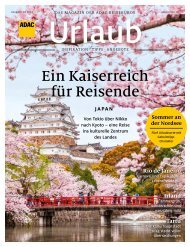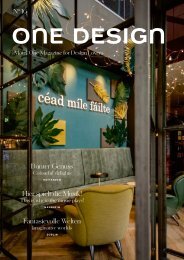Jaguar Magazine BLOCKBUSTER – English
Im Fokus der Jaguar Magazine Ausgabe 02-2015: Kassenschlager aller Art. Unter anderem sprachen wir mit Tom Hiddleston, dem Star vieler Hollywood-Blockbuster (Avengers, Thor) und Gesicht der neuesten Werbekampagne von Jaguar. Mehr als ein Nebendarsteller – wir verraten welche Jaguar-Modelle in welchen Filmen eine Rolle spielen. Außerdem stellen wir in zwei exklusiven Fotoshootings den revolutionären F-PACE und die neue Familie der Jaguar-Limousinen vor.
Im Fokus der Jaguar Magazine Ausgabe 02-2015: Kassenschlager aller Art. Unter anderem sprachen wir mit Tom Hiddleston, dem Star vieler Hollywood-Blockbuster (Avengers, Thor) und Gesicht der neuesten Werbekampagne von Jaguar. Mehr als ein Nebendarsteller – wir verraten welche Jaguar-Modelle in welchen Filmen eine Rolle spielen. Außerdem stellen wir in zwei exklusiven Fotoshootings den revolutionären F-PACE und die neue Familie der Jaguar-Limousinen vor.
You also want an ePaper? Increase the reach of your titles
YUMPU automatically turns print PDFs into web optimized ePapers that Google loves.
TRAVEL<br />
Etienne Dalançon is gazing out of a large<br />
window at one of the most incredible<br />
urban views in the world: “Just look at the<br />
lights and endless landscape. You look<br />
down and see a city constantly evolving <strong>–</strong><br />
a new building, a new road-things<br />
happen here ten times faster than<br />
anywhere else on the planet, it’s almost too fast.” We’re on<br />
the 87th floor of Shanghai’s Park Hyatt which, when it<br />
opened in 2007, was the world’s highest hotel in the<br />
world’s second tallest building, the Shanghai World Financial<br />
Centre (SWFC). Dalançon is the hotel’s general<br />
manager and even though he sees this view everyday, as<br />
he says, it never fails to inspire.<br />
Until this year, the SWFC Tower was the landmark about<br />
which everything in the city seemed to revolve and his<br />
hotel played its role as an exclusive meeting and entertaining<br />
hub <strong>–</strong> the luxury calm in the middle of the storm,<br />
popular with tourists and ‘staycationing’ locals alike:<br />
“There was a joke running when we first opened. Although<br />
you can see the hotel from anywhere in the city, most of<br />
the taxi drivers didn’t know the address because the<br />
streets were so new, so we told our guests that ‘should you<br />
have any trouble, not to worry, just point out the building<br />
to the taxi driver and he will drive you home’.”<br />
But in a city of constant construction and change, no<br />
building can hold on to a superlative for long. In 1993, the<br />
Government made plans for three adjacent super-tall<br />
towers in Pudong, which is the east side of the city. Photos<br />
from the early 90s show fields and farms. Today Pudong is<br />
China’s financial heart.<br />
The first of these skyscrapers was completed in 1999: The<br />
Jin Mao Tower (88 floors) with its beautiful neo-art-deco<br />
angles. Then nine years later came the sleek SWFC (101<br />
floors) known locally as ‘The Bottle Opener’ due to its<br />
rectangular aperture at the top. And this year, the kingpin<br />
is finally ready: The world’s new second tallest building,<br />
the Shanghai Tower (121 floors), will open for business in<br />
October. “The Government has made it happen and on<br />
time,” points out Dalançon. “Such long-term and massive<br />
projects are very difficult to plan and achieve. Shanghai<br />
can be proud.” The state-owned Shanghai Tower with its<br />
elegantly twisting form and eco-building credentials is a<br />
reflection of that pride.<br />
Designed by US-based Gensler architects, its lead architect<br />
Jun Xia has talked of the tower being a vertical city and an<br />
integrated place for work and play. It will be able to house<br />
16,000 people daily with its mix of office, commercial and<br />
public space <strong>–</strong> with a freely accessible sky-garden located<br />
every 15 floors. Such inclusivity of use is a genuine<br />
achievement when most skyscrapers limit their public<br />
spaces, preferring instead to provide more rentable square<br />
metres for office use.<br />
Shanghai is a city divided by the Huangpu river: east and<br />
west, new and old. Pudong may have the postcard highrise<br />
skyline, but directly across the river is Puxi, with a<br />
famous riverside promenade called the Bund that’s arguably<br />
Asia’s finest architectural mile.<br />
It’s a succession of 20th century buildings, many were<br />
originally banks, that span styles from art deco to baroque<br />
to renaissance and are now five-star hotels, restaurants,<br />
shops and bars. The wide pedestrianised zone of the Bund<br />
is a good-natured battleground of selfie-sticks, tourists,<br />
wedding photographers and local families out for a stroll,<br />
especially at dusk when Pudong’s building-sized advertising<br />
displays begin their vespertinal duties.<br />
Explore a few streets back from the Bund and you’ll<br />
wander into the tightly packed old town, which contains<br />
the true communities of the Shanghainese. British novelist,<br />
J.G. Ballard, who was born in the city, described them<br />
better than anyone in his autobiography, Miracles of Life:<br />
“Inside every open doorway a small business was flourishing.<br />
A miasma of frying fat floated into the night, radio<br />
announcers gabbled, gongs sounded the start or end of a<br />
work shift, sparks flew from the lathes of a machine shop,<br />
mothers breastfed their babies as they sat patiently by<br />
pyramids of melons, traffic horns blared, sweating young<br />
men in singlets smoked in doorways… the ceaseless<br />
activity of a planetary hive.”<br />
The old town is slowly being dismantled, every six months<br />
another block is razed, people re-homed in the expansive<br />
suburbs <strong>–</strong> their disappearance notable on Google Map<br />
updates. Occasionally folk are unwilling to move out of<br />
lifelong homes, so-called ‘nail houses’, because they refuse<br />
THE <strong>BLOCKBUSTER</strong> ISSUE j 39


















